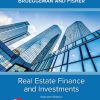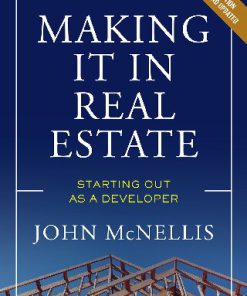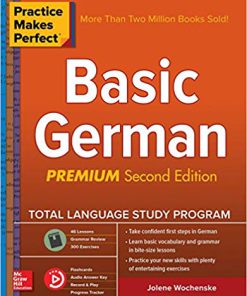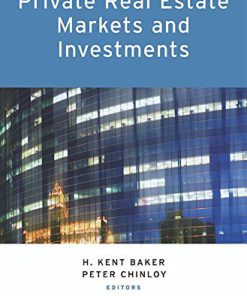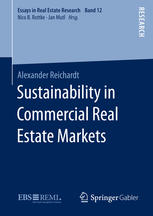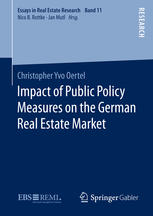Understanding German Real Estate Markets 2nd Edition by Tobias Just 3319320311 9783319320311
$50.00 Original price was: $50.00.$25.00Current price is: $25.00.
Understanding German Real Estate Markets 2nd Edition by Tobias Just – Ebook PDF Instant Download/DeliveryISBN: 3319320311, 9783319320311
Full download Understanding German Real Estate Markets 2nd Edition after payment.
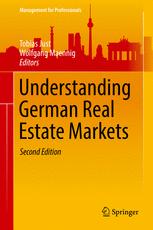
Product details:
ISBN-10 : 3319320311
ISBN-13 : 9783319320311
Author: Tobias Just
In this book, experts discuss how German real estate values have remained stable throughout the financial crisis, even though transaction volumes have been very volatile since 2005. Consequently, risk-averse national and international investors have started to invest in virtually all German real estate asset classes. This book tries to answer what has made the German real estate markets more resilient to shocks than many European real estate markets by analyzing the economic, regulatory and demographic environment. In 30 well-structured chapters, experts from both the academic and professional world analyze structural and current issues of German real estate markets. Readers will get a deep understanding of what makes the German real estate market special and where potential opportunities and threats in Europe’s largest real estate market exist.
Understanding German Real Estate Markets 2nd table of contents:
Part I: Macro Environment
Real Estate Data Sources in Germany
1 Introduction
2 General Market Data
2.1 Authorities Responsible for Official Statistics
2.2 General Market Data in Official Statistics
2.2.1 Real Estate Stock and Building Activity
2.2.2 The Real Estate Industry
2.2.3 Demographic Trends
2.2.4 Labor Market Data
2.2.5 Interest Rates
3 Real Estate Prices and Rents
3.1 Methods of Calculating Property Price Indices
3.2 Rents and Prices in the Official Statistics
3.3 Rents and Prices from Private Sources
3.3.1 Association of German Pfandbrief Banks
3.3.2 Association of Real Estate Agents
3.3.3 Brokers and Banks
3.3.4 bulwiengesa
3.3.5 GEWOS Institut für Stadt-, Regional- und Wohnforschung
3.3.6 Hypoport
3.3.7 Immobilienscout24.de
3.3.8 Investment Property Databank
3.4 Differences Between the Price Indices
4 Outlook
References
Size and Impact of Real Estate Sector and Its Role for Business Cycles and Growth
1 Real Estate Markets and the Economy
2 Construction Activity in Germany
3 Future Prospects
Bibliography
Demographic Outlook and the Implications for Real Estate Markets
1 Demographic Development in Germany
1.1 Population Shrinking and Ageing
1.2 Significant Regional Differences
1.3 Comparison with Other European Countries
2 Implications for Housing Markets
2.1 The Number of Households Continues to Increase
2.2 Demand for Living Space to Grow
2.3 Asymmetric Price Reactions
3 Demand for Commercial Real Estate
3.1 Office Property
3.2 Retail Property
4 Concluding Remarks
Bibliography
Germany´s Regional Structure
1 Introduction: A Brief History of the Past 70 Years
2 Economic Power in the German Districts
2.1 Gross Domestic Product and Disposable Income
2.2 Labor Markets
2.3 The Infrastructure Divide
3 Economic Growth Since the Turn of the Millennium
3.1 Regional Economic Growth and Labor Markets
3.2 Education and Innovation
3.3 Taxes and Public Expenditures
4 Convergence or Divergence in Germany?
5 Implications for Real Estate Professionals
Bibliography
The German City System
1 The Significance of City Systems
2 Theories and Models of the Urban Hierarchy
3 History of the German Urban System
4 Today´s Status
4.1 The Functional Division of Labor in German Cities
5 Future Outlook for the German Urban System
References
The Micro-Cosmos of German Cities: New Insights into the Supply of and Demand for Urban Amenities
1 The Determinants of Neighborhood Value: A Typology of Urban Amenities
2 The Primary PS Scores: Centrality, Urbanity, Nature, Status and the Aggregate PS Score
3 The Applications
3.1 The PS Search for Neighborhoods
3.2 Applications for Real Estate Agents
3.3 Applications for Real Estate Platforms
3.4 Demand Indices: Applications for Developers and Investors
4 Conclusion
References
Sustainable Buildings
1 Sustainability
2 Integral Planning
3 The German Certification System
3.1 Overview
3.1.1 Advantages of the Certificate
3.2 Evaluation Areas
3.2.1 An Overview of the Criteria
3.2.2 The Building Owner´s Role
3.2.3 The Auditor´s Main Tasks
3.2.4 Auditors´ Optional Advising Tasks
3.2.5 Optimizing a Building
3.3 International Development
3.4 The DGNB International Certification System
4 Added Value of a Certification
Bibliography
Part II: Judicial Framework
Regulations and Laws on Real Estate Agents, Notaries, Cadastres and Rent Increases
1 Introduction
2 The German System of Cadastres and Land Registers
2.1 Cadastre
2.2 The Land Register
2.2.1 The Land Register´s Key Role for Transactions
2.2.2 Applications to the Land Registry
2.2.3 Inspecting the Land Register
3 German Brokerage Law
3.1 The Estate Agent
3.2 The Estate Agent´s Contract
3.2.1 Principles and Deviating Regulations
3.2.2 Particularities Regarding the Brokerage of Residential Space
3.3 The Estate Agent´s Fee
3.3.1 Payment of the Estate Agent´s Fee
3.3.2 Special Procedures for Payment of the Estate Agent´s Fee in the Brokerage of Properties for R
4 Residential Lettings: Regulation of Rents
4.1 Regulation of Rents for New Leases
4.1.1 Exceptions and Special Provisions
Stepped and Indexed Rents
Exceptions from the Rent Cap
4.2 Regulation of Rents for Existing Leases
4.3 Residential Lettings: Rent Increases Following Modernizations
4.3.1 Allocation for Modernizations
4.3.2 Rent Cap and Modernizations
5 Regulations and Laws Relating to the Notary Public
5.1 The Notary Public
5.2 The Notarization
6 Conclusion, and the German Situation Compared to that of Other Countries
Bibliography
Legal Framework for Real Estate Asset Classes
1 Introduction
2 Direct Investments
3 Indirect Investments
3.1 German Stock Corporation
3.1.1 General Structure
3.1.2 Investments in Stock Corporations
3.2 Real Estate Investment Trusts
3.2.1 General Structure
3.2.2 Investments into G-REITs
3.2.3 Further Development
3.3 Real Estate Investment Funds
3.3.1 The New KAGB
3.3.2 Open-End Funds
General Structure of Open-End Real Estate Funds
Investments in Open-End Funds
Further Development
3.3.3 Closed-End Funds
General Structure
Investments into Closed-End Funds
Further Development
Closed-End and Open-End Real Estate Fund in Comparison (Fig.3)
3.4 Conclusion
Bibliography
Valuation of Real Estate in Germany
1 German Valuation Standards
2 Value Definitions
2.1 Market Value [Verkehrswert]2.2 Mortgage Lending Value [Beleihungswert]2.3 Investment Value [Investitionswert]3 Market Transparency Through the Boards of Expert Appraisers
3.1 Collection and Analysis of Data
3.2 Publications
3.3 Valuation
4 Valuations in Line with the German Federal Ordinance for Property Valuation
4.1 Introduction
4.2 Data Required
4.3 Valuation Methodologies
4.3.1 Sales Comparison Approach
4.3.2 Income Approach
General Approach
Dynamic Income Approach
4.3.3 Cost Approach
5 Selected Aspects of German Valuation Guidelines
5.1 Introduction
5.2 Selection of Valuation Approach
5.3 Ground Leases
5.4 Valuation Parameters
6 Methodological Differences Between German and International Income-Related Valuation Approaches
7 Summary
Bibliography
What Germany´s Amended Tenancy Laws Do and What They Don´t
1 Introduction
2 The Bestellerprinzip: Why It Makes Life Difficult for Prospective Tenants
3 Rent Indexes: Important Benchmarks on Shaky Ground
4 Modernizations: As Necessary as They Are Uneconomical
References
Commercial Leases
1 Introduction
2 Duration
3 Provisions Regarding Formal Requirements
3.1 Requirement of Written Form (“Schriftformerfordernis´´)
3.2 Other Requirements
4 Security for the Lease Contract in Rem
5 Rent/Rent Review/Operating Costs
5.1 Stable Value Clauses/Other Adjustment Clauses
5.2 Market Rent Review
5.3 Sales-Related Rent/Profit-Related Rent
5.4 Operating Costs
5.5 Value Added Tax
6 Maintenance and Repair
7 Decorative Repairs (“Schönheitsreparaturen´´)
8 Security
9 Subletting
10 Sale and Lease Back
11 Lease Contract in Case of the Sale of the Site
12 Registered Lease (“Dauernutzungsvertrag´´)
12.1 Advantages of a Registered Lease Contract
12.2 Disadvantages of the Registered Lease Contract
12.3 Form of the Registered Lease Right
12.4 Reversion
12.5 Relationship Between the Registered Lease and Liens
13 Hotel Contracts
Bibliography
Planning and Building Law
1 Introduction
2 Urban Development Law
2.1 Legal Framework
2.2 Urban Land-Use Planning
2.2.1 Preparatory Land-Use Plan
2.2.2 Binding Land-Use Plan
2.2.3 Informal Plans
2.2.4 Procedure of Urban Land-Use Planning
2.2.5 Reallocation of Property Rights
2.2.6 Provision of Local Public Infrastructure
2.3 Permissibility of Development Projects
2.3.1 The Permissibility of Development Projects Within the Area Covered by a Legally Binding Land-U
2.3.2 The Permissibility of Development Projects Within Built-Up Areas
2.3.3 Building in the Undeveloped Outskirts Area
2.4 Instruments of the Special Urban Development Legislation
3 Building Regulations Law
3.1 Procedural Building Regulations Law
3.2 Substantive Building Regulations Law
Bibliography
Part III: Tax and Subsidy Framework
Tax Framework for Investing by Asset Classes
1 Introduction
2 German Stock Corporation
2.1 Entity Level Taxation
2.2 Shareholder Level Taxation
2.2.1 Taxation of Dividends
2.2.2 Taxation of Capital Gains
3 Real Estate Investment Trusts
3.1 General Structure
3.2 Entity Level Taxation
3.3 Shareholder-Level Taxation
3.3.1 Profit Distributions
3.3.2 Capital Gains Taxation
4 Closed-End Funds
4.1 Fund Level Taxation
4.2 Investor Level Taxation
4.2.1 Rental Income and Capital Gains from Disposal of Real Estate
4.2.2 Capital Gains from the Disposal of Fund Interests
5 Open-End Funds
5.1 Fund Level Taxation
5.2 Investor Level Taxation
5.2.1 Rental Income and Capital Gains from Disposal of Real Estate
5.2.2 Capital Gains from the Disposal of Fund Interests
6 Summary
Bibliography
German Taxation of Inbound Real Estate Investments
1 Introduction
2 German Taxation of Real Estate Investments
2.1 German Corporate Income Tax and Solidarity Surcharge
2.1.1 Overview
2.1.2 Foreign Vehicles
2.1.3 Partnerships
2.1.4 Interest Deductibility
2.1.5 Forfeiture of Tax Losses
2.1.6 Shareholders
2.1.7 Tax Authorities´ Specific Instruction Right to Withhold Taxes on Account of Foreign Investors
2.1.8 Lenders
2.2 German Trade Tax
2.2.1 Overview
2.2.2 Economic Importance of German Trade Tax
2.2.3 Trading Income
2.2.4 German Permanent Establishment
2.2.5 Extended Trade Tax Exemption
2.3 German Real Estate Transfer Tax
2.3.1 Overview
2.3.2 Asset Deals
2.3.3 Share Deals
2.3.4 Exemptions
2.3.5 Notifications
2.4 German Value Added Tax
2.4.1 Overview
2.4.2 Real Estate Letting
2.4.3 VAT Option for Real Estate Letting
2.4.4 Input VAT and Input VAT Corrections
2.4.5 Asset Deals
2.4.6 Share Deals
2.5 German Real Estate Tax
2.6 German Tax Liability
3 Conclusion
Bibliography
Monument Protection and Zoning: Regulations and Public Support from an International Perspective
1 Monument Protection
2 Redevelopment Law (“Sanierungsrecht´´)
3 Preservation Statutes and Social Environment Protection (“Erhaltungs- und Milieuschutzsatzung´´
4 Evaluating Regulations and Public Supports for Monument Protection and Modernization from an Inter
References
Part IV: Financing
Commercial Property Financing
1 Market Changes in Recent Years
1.1 Market Changes Due to Internationalization
1.2 Market Changes Due to the Financial Crisis
2 Types of Financing
2.1 Asset Financing
2.2 Project Financing
3 Documentation and Risk Hedging
3.1 Due Diligence
3.2 Loan Agreement
3.3 Collateral
3.4 Covenants
3.4.1 Loan-to-Value Covenant (LTV)
3.4.2 Interest Coverage Ratio (ICR)
3.4.3 Debt Service Coverage Ratio Covenant (DSCR)
3.4.4 Non-financial Covenants
3.4.5 Sanctions for Covenant Breaches
3.5 Interest Rate and Currency Risks
3.5.1 Interest Rate Swaps
3.5.2 Currency Swaps
4 From Pfandbrief via CMBS Back to Pfandbrief
4.1 What Is a Pfandbrief?
4.2 What Are CMBS?
5 Changes in the Lending Environment
5.1 The Renaissance of Club Deals
5.2 Margin Adjustments
6 Changes in Due Diligence and Adjustment of Loan Agreements
6.1 Due Diligence
6.2 LTV
6.3 Covenants
6.4 Formal Requirements for Rental Agreements
7 Refinancing Existing Loans
7.1 Pfandbriefe
7.2 CMBS
7.3 Loan Sales Market
8 Outlook
Bibliography
Going Public and MandA in the German Real Estate Market
1 Going Public
1.1 Public Real Estate Market Overview
1.2 Characteristics of the Public Real Estate Market
1.3 Investment Criteria
1.4 Pricing
2 IPO Process
2.1 Preparation Phase
2.2 Structuring
2.3 Marketing Strategy
2.4 Offering
2.5 Managing the Aftermarket
3 Non-public Mergers and Acquisitions
3.1 Market Overview
3.2 Investor Landscape
3.3 MandA Process in the Non-public Markets
4 Public Market Merger and Acquisitions
4.1 Preparation
4.2 Offer Announcement
4.3 The Offer Document
4.4 Acceptance Period
4.5 Post-takeover Integration
5 Takeover Related Issues
Bibliography
German Open-End Real Estate Funds
1 Introduction
2 Institutional Design and Legal Environment
2.1 Liquidity Shortages and Recent Law Reforms
3 Historical Performance and Portfolio Composition
4 Understanding the Success of OEREFs in Germany
4.1 The Nature of Liquidity Crises
4.2 Turbulences in the German Market
5 Concluding Remarks
References
German Closed-End Funds
1 Introduction
2 Definition and Elements of Closed-End Funds
2.1 Definition and Characteristics
2.2 Players and Structure in Brief
2.3 Asset Classes
2.4 Asset Manager, Capital Investment Companies, Distributors and Investors
2.5 Market Volume
2.6 Fund Types
2.7 Regional and Functional Allocation
3 Legal Framework of German Closed-End Funds
3.1 Closed-End Domestic Investment Assets
3.2 Product Restrictions for Closed-End Public AIFs Under the KAGB
3.2.1 Requirements for Blind Pool Constructions
3.2.2 Permitted Assets
3.2.3 The Principle of Risk Diversification
3.2.4 Leverage and Exposure
3.2.5 Currency Risks
3.3 Legal Framework Conditions of Product Structuring
3.3.1 Articles of Association
3.3.2 Contractual Requirements
3.3.3 Management and Representation
3.3.4 Advisory Board
3.3.5 Members of the Investment-KG
3.4 Investor´s Liability
3.5 Terms and Conditions of Investment
3.6 Sales Prospectus and Key Investor Information
3.7 Valuation of Assets
3.8 Depositary
3.9 Marketing
3.9.1 Extended Marketing Concept and Abolition of Private Placements
3.9.2 Marketing Notice
3.10 Procedure and Advertising
3.11 Outlook: MiFID II
3.11.1 Applicability to Asset Managers
3.11.2 Inducements
3.11.3 Dealing Commission
3.11.4 Product Governance
3.11.5 Disclosure Obligations
4 Success Factors and Summary
Bibliography
REOCs and REITs
1 REOCs and REITs
1.1 Definition of REOCs
1.2 Differences Between REOCs and REITs
2 REOCs and REITs in the Market Environment
2.1 REOCs and REITs in the Investment Spectrum
2.2 REOCs and REITs in the German Context
2.3 REOCs and REITs in the European Context
3 Success Factors and Value Drivers of REOCs and REITs
3.1 Management Quality and Track Record
3.2 Orientation of the Business Model
3.3 Exploitation of Market Cycles
3.4 Value Creation in the Portfolio
3.5 Project Development
3.6 Growth Fantasy
3.7 Size, Liquidity and Capital Structure
3.8 Transparency and Corporate Governance
4 Final Remarks
Bibliography
Possible Applications of Derivatives
1 Real Estate Futures on International Derivatives Exchange
2 Correlation Between Real Estate Indices, Listed Real Estate Companies and Stock Market
3 Exchange Traded Real Estate Derivatives
4 Over-The-Counter (OTC) Derivatives
5 Options: The Right, Not the Obligation
6 Benefits and Costs of Derivatives on Real Estate Indices
7 The Bases for Derivatives
8 IPD German Property Index DIX Deutscher Immobilien Index
9 Other Available Real Estate Indices
10 Outlook: Substantial Growth Potential for Real Estate Derivatives
Bibliography
Part V: Asset Classes
Development of Residential Property
1 Introduction
2 The German Residential Market in an International Context
3 The German Reunification and Its Effect on the Residential Market
4 Development of Residential Demand
5 Supply Situation
6 Market Performance
7 Outlook
Bibliography
German Office Markets
1 Introduction
2 General Facts
3 Office Employment
4 Office Stock and Vacancy
5 Office Take-Up
6 New Supply
7 Market Rents
8 Investment Market and Yields
9 Total Return
Bibliography
Retail Property Markets
1 Overview of German Retail Trade
1.1 Private Consumption and Retail Demand
1.1.1 Private Consumption and Purchasing Power
1.1.2 Retail Turnover and Competition
1.1.3 Structure of the German Retail Market
1.2 German Retail Landscape
1.2.1 Retail Formats
1.2.2 Sales Area and Locations
2 Retail Property Investment
2.1 Prime Locations
2.2 Other Locations
3 Retail Property Rent
3.1 Prime Locations
3.2 Other Locations
4 Brief Outlook
Bibliography
Hotel Market Germany
1 Supply and Demand
1.1 Supply
1.2 Demand
2 Focus on the Key Markets: The Big Seven
2.1 Performance in an International Comparison
3 Secondary and Tertiary Markets
3.1 Hotel Markets in Secondary and Tertiary Cities
3.2 Resort Hotel Market
4 Key Players: Hotel Operators
4.1 German Brands Versus International Brands
5 Type of Operations: Lease Contracts
5.1 Characteristics of Lease Contracts
5.2 Recent Development
5.3 Hybrid Contracts
6 Valuation of Hotel Investments: Characteristics of German Valuation Standards
7 Players in the German Hotel Investment Market
8 Investment Market
9 Summary
References
“Unternehmensimmobilien´´: An Asset Class of High Potential
1 Changed Work Environments and Manufacturing Processes Cause Demand for Floor Space to Shift
2 Unternehmensimmobilien Asset Types
2.1 Converted Properties
2.2 Logistics Properties
2.3 Business Parks
2.4 Light Manufacturing Properties
3 The Unternehmensimmobilien Market
3.1 The Unternehmensimmobilien Investment Market
3.1.1 Sale-and-Rent-Back
3.2 The Unternehmensimmobilien Letting Market
4 Unternehmensimmobilien as Investment Assets
4.1 Value-Based Investment Approach
4.2 Performance of Unternehmensimmobilien
4.3 Asset Management Requirements
5 Summary and Outlook
Bibliography
Ongoing Catch-Up Potential for German Real Estate Returns
1 Globalization: Also for the Real Estate Investors
2 Real Estate Returns in Comparison with Other Asset Classes
3 Total Returns in a Global Comparison
4 Total Return and Risk
5 Final Remarks
Bibliography
Part VI: Public Real Estate
Public Real Estate
1 Relevance, Functions and Future Challenges of Public Real Estate: Assets and Management
2 Definition Public Real Estate Management (PREM)
3 Potential for Optimization in Public Real Estate Management
4 Development of Public Real Estate Management: Federal Government, Federal States, Communities and
4.1 Federal Government
4.2 Federal States
4.3 Communities, Cities
5 Key Success Factors Public Real Estate Management
6 Objectives, Strategies, Organizational Structures
7 Added Value by Professional Public Real Estate Management
7.1 Portfolio and Risk Management
7.2 Facility Management
7.3 Property Management
7.4 Public Private Partnership (PPP)
7.5 Disposing of Real Estate
8 Steps to Professional Public Real Estate Management
9 Summary
Bibliography
PPP and Infrastructure
1 Introduction
2 Structure and Main Characteristics of PPP
3 Financing of PPP-Projects
4 Institutional Set Up for PPPs in Germany
5 Applied Contract Models
6 German PPP Market
7 Deal Flow
8 Outlook
People also search for Understanding German Real Estate Markets 2nd:
thank you for understanding german
thanks for understanding german
understanding german shepherds
thanks for your understanding german
understanding german cases
Tags: Understanding, German Real, Estate Markets, Tobias Just
You may also like…
Business & Economics - Human Resources
Making it in Real Estate Starting Out as a Developer 2nd Edition John Mcnellis
Politics & Philosophy - Anthropology
Business & Economics
Real Estate Photography for Everybody Boost Your Sales with Any Camera 2nd Edition Castle
Business & Economics - Mathematical Economics
Private Real Estate Markets and Investments 1st Edition H. Kent Baker
Business & Economics - Real Estate
Sustainability in Commercial Real Estate Markets 1st Edition Alexander Reichardt
Business & Economics
Business & Economics - Real Estate
Politics & Philosophy
Just financial markets? : finance in a just society First Edition Herzog



